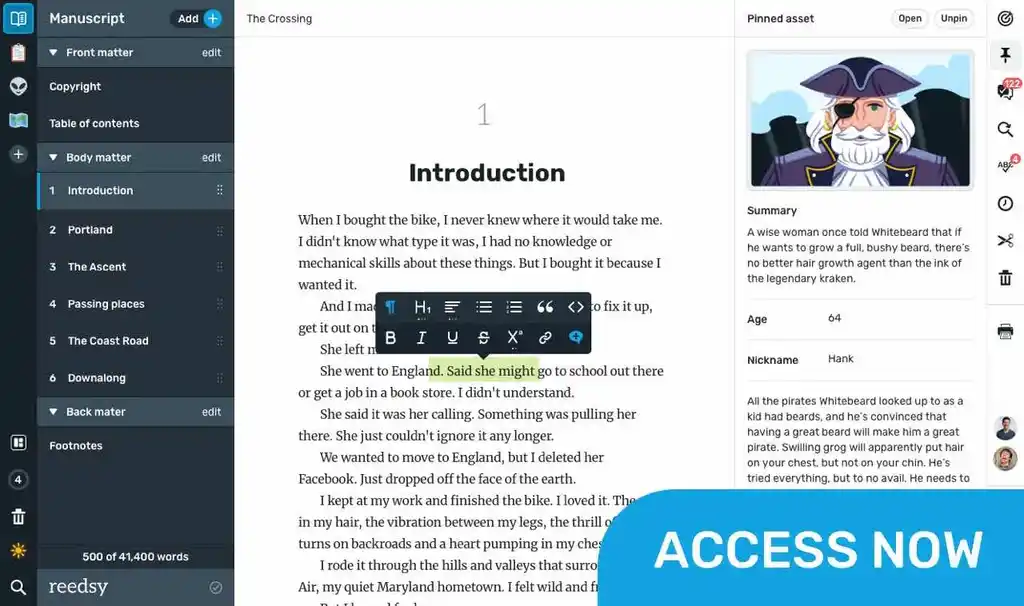If you were a teenage girl in the 90s, you were either a Vampire Girl, a Witch Girl, a Horse Girl, or you were popular. Suffice it to say, I’ve been wanting an adaptation of Anne Rice’s Lives of the Mayfair Witches trilogy since before I had a driver’s license. But even as a 90s weirdo tween, I still understood that the book was so long the story would be unadaptable.
Despite knowing better, I decided to watch the AMC series with optimism this past January, but Mayfair Witches was as disappointing as I expected. Everyone knows not to expect much from TV adaptations but slogging through the first season of Mayfair Witches still stung.
The first book of the Mayfair trilogy, The Witching Hour, clocks in at a hefty pre-internet attention span of 1,056 pages, and is at its core, three books in one. I was hoping the volume of source material alone would give producers the ability to start on the right foot and prevent what I’ve started calling The Bitchening—the current trend of turning powerful, complex women into magical girl bosses who just keep whining, infighting, and are easily manipulated away from their power by a man or a baby or both. It did not.
It’s hard to summarize a thousand-page book but like all Rice novels, after reading The Witching Hour, you feel steeped in the vivid history of the Mayfair family. Some of the fun of reading Anne Rice is just being pulled along on a journey that starts with a doctor in San Francisco and ends with the demon ghost of Anne Boleyn’s bastard son trying to knock up that doctor so he can become embodied after hundreds of years possessing the Mayfairs. That’s what Lasher is, by the way, the demon ghost reincarnation of a saint born to Anne Boleyn called a Taltos. He was born human, became a priest, and was killed during the Reformation, only to have his soul reawakened by Rowan’s ancestor, Suzanne. This is the kind of silly shit you can only hope for from Anne Rice, which is why trying to successfully adapt this story to TV was such a shot in the dark.
The Bitchening—the current trend of turning powerful, complex women into magical girl bosses who just keep whining, infighting, and are easily manipulated away from their power by a man or a baby...
The Witching Hour starts with neurosurgeon Rowan Mayfair discovering she has the power to kill or to heal with her mind. Rowan saves a man named Michael Curry from drowning, after which he discovers he has a type of touch-induced clairvoyance and can see the history of an object or person by touching them. He and Rowan become lovers and travel to Michael’s childhood home of New Orleans, where Rowan knows she’ll get more information on the mysterious being she sees in her dreams (Lasher) and learn more about her powers and her family.
The TV series showcases Rowan becoming aware of her powers but takes a sharp left and never manages to catch back up with the book, bolstered by the decision to combine Michael’s character with another character. Michael Curry is combined with Aaron Lightner, a Talamascan scholar assigned to monitor the Mayfair family. The producers combined these two characters into Ciprien Grieve (Tongayi Chirisa) who is just a tool for explaining Lasher’s exposition and not a fully-realized new addition. For the best of both characters, Ciprien is a Talamascan scholar assigned to watch the Mayfair family, who has Michael’s powers of clairvoyant touch. Whoop de do.
The whole show feels like a cash grab after the success of the adaptation of Interview With The Vampire. Most Rice fans know that the Vampire Chronicles eventually dovetail with the Mayfair trilogy when Rowan falls in love with Lestat in Blood Canticle, which is probably the only saving grace for Mayfair Witches at this point, with most viewers just waiting to see when the shows will cross over. The whole series seemed like they were just hoping proximity to other characters in the Rice universe would be enough, which it obviously was since it was renewed for a second season. It was simply too much story to cram into 8 episodes.
Instead of using the literal hundreds of pages of material at their disposal, they created something uncomfortable and hard to watch, that left me feeling like I got suckered into reading a colleague’s fanfiction mashup. I got weird Outlander vibes from the flashback scenes. Even though Lasher’s (Jack Houston) human origins were in Scotland, the flashbacks felt like they belonged in another show altogether. What the show lacked most was the almost campy Southern Gothic Anne Rice atmosphere. Instead, Lasher is dressed like a cocaine kingpin and the emerald pendant that links Lasher to Rowan has an Etsy Steampunk store vibe that ups the cash grab factor. They tried to harken back to other productions in the Rice universe in episode 5, “The Thrall,” where Ciprien, in a fugue state, has a vision of a previous Talamascan scholar annoyingly named Stuart Townsend. This is a forced cheeky connection to the 2002 film Queen of the Damned, where Lestat was tepidly played by Stuart Townsend. Womp womp. Hearing “Oh, you’re Stuart Townsend” was the only thing that made me look up from my phone that episode.
The crux of the Mayfair’s story and relationship with the Taltos is bound up in Lasher’s generational manipulation of the family, their wealth, and their powers until the thirteenth generation when a more powerful witch, Rowan (Alexandra Daddario) will be able to carry a magical fetus strong enough to embody him. This is typical Anne Rice fare, but the producers wrote Rowan Mayfair with static aimless panic that ends with fierce echoes of Bella Swan. In deviating from the source material and creating new storylines, they lost a lot of opportunities.
Another new character Odette Grieve, (Keyara Milliner) Ciprien’s sister, was like an unfired Checkov’s gun. Odette is a gestational surrogate and I assumed she’d have a role here, that Lasher or another Taltos would try to become embodied using her fetus, and body horror would ensue. Were producers trying to normalize surrogacy or did they just forget they started a certain storyline for her character? When producers kind of bumble around inclusivity and come at it sideways it comes off disingenuous and very weird, especially with the heavy amount of fertility/pregnancy conversation they put into the storyline. Even if they went off book, they missed the opportunity to parallel that with the witch hunters they created: white Christian men aimed at taking power away from the Mayfair women and women in general. If showrunners couldn’t stick to the original plot, why did they create so many loose thread characters they couldn't follow up on?
The whole thing was a disappointing mess and I should have known better than to get my hopes up. Anne Rice is simultaneously so simple to adapt while also extremely difficult to get right, so entrenched is the readership and fandom. To watch an Anne Rice adaptation is to be so angry you can’t even see your TV because you’re throwing shit at it. So yes, obviously, I’ll be watching season two.
Get The Witching Hour at Bookshop or Amazon

Write your vampire story in Studio
Reedsy's free writing app lets you set writing goals and track your progress, so you can — finally — write that book!

About the author
Megan won a sci-fi short story contest when she was 15 and got real smug about it. It’s been 20 years and she’s still smug about it. A native Upstate New Yorker, Megan is also a professional nomad and has lived in and worked in many different states on both coasts. She is adamantly against having an address she can remember for more than two years. She currently lives in Boise, but we’ll see about that. Her collection of essays, This Book Brought To You By My Student Loans is out with Clash Books. You can find her fiction in Luna Station Quarterly and Hello Horror, and her comedy nonfiction in Ravishly, Daily Drunk Mag, and Spoonie Magazine.






